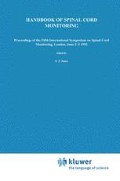Abstract
Maintenance of the functional integrity of the spinal cord is a major concern for every spine surgeon. Severe neurologic complications may occur following surgical correction of spinal deformity and recovery is proportional to the speed of removal of the instrumentation1,2. In the past, a careful physical examination in the recovery room was the earliest warning of cord injury. During the last two decades, gross physical examination of the partially awakened patient during the operation — the wake-up test — has been widely used. The desire of many researchers and clinicians to find a better method of evaluating cord function intraoperatively, has resulted in renewed interest in the techniques of evoked response monitoring.
Access this chapter
Tax calculation will be finalised at checkout
Purchases are for personal use only
Preview
Unable to display preview. Download preview PDF.
References
MacEwen GD, Bunnel WP, Sriram K. Acute neurological complications in the treatment of scoliosis. A report of the SRS. J. Bone Joint Surg. 1975;57A:404–408.
Dawson EG, Sherman JE, Kanim LE, Nuwer MR. Spinal cord monitoring: results of the scoliosis research society and the European spinal deformity society survey. Spine. 1991;16(Suppl 8):361–364.
Dawson GD. Cerebral responses to electrical stimulation of peripheral nerve in man. J Neurol Neurosurg Psychiatr. 1947;10:134–140.
Bunch WH, Scarff TB, Trimble J. Spinal cord monitoring — current concepts review. J Bone Joint Surg. 1983;65A:707–710.
Ben-David B. Spinal cord monitoring. Orthop Clin North Am. 1988;19:427–448.
Evoked Potentials Committee of the American Electroencephalographic Society. Guidelines for intraoperative monitoring of sensory evoked potentials. J Clin Neurophysiol. 1987;4: 397–416.
Lubicky JP, Spadarao JA, Yuan HA, Frederickson BF, Henderson N. Variability of somatosensory cortical evoked potential monitoring during spinal surgery. Spine. 1989;14:790–798.
Nash CL, Brown RH. Current concepts review: Spinal Cord Monitoring. J Bone Joint Surg 1989;71A:627–630.
Engler GL, Spielholz NI, Bernhard WN, Danzinger F, Merkin BA, Wolff EE. Somatosensory evoked potentials during Harrington instrumentation for scoliosis. J Bone Joint Surg. 1978;60A:528–532.
Gollehon D, Kahanovitz N, Happel LT. Temperature effects on feline cortical and spinal evoked potentials. Spine. 1983;8:443–446.
Grundy BL. Intraoperative monitoring of sensory evoked potentials. Anaesthesiology. 1983;58:72–87.
Szalay EA, Carollo JJ, Roach JW. Sensitivity of Spinal Cord Monitoring to intraoperative Events. J Ped Orthop. 1986;6:437–441.
Lesser RP, Raudzens P, Lüders H et al. Postoperative neurological deficits may occur despite unchanged intraoperative somatosensory evoked potentials. Ann Neurol. 1986;19:22–25.
Dinner DS, Shields RW, Lüders H. Intraoperative spinal cord monitoring. In: Rothman RH and Simeone FA, (eds). The Spine, 3rd Edition, Philadelphia-London: W.B. Saunders; 1992:1801–1814.
Dunn C, Jardine AD, Smith NJ, Webb JK, Yeomans PM. Electrophysiological monitoring of spinal cord function during scoliosis surgery. Electroencephalogr Clin Neurophysiol. 1984;58:15P.
Hamilton A, Webb JK. The role of vertebrectomy in correction of spinal deformity. ESDS Meeting, Lyon, France. 1992.
Aminoff MJ, Goodin DS, Barbaro NM et al. Dermatomal somatosensory evoked potentials in unilateral lumbosacral radiculopathy. Ann Neurol. 1985;17:171–176.
Machida M, Asai T, Sato K et al. New approach for diagnosis in herniated lumbosacral disc: Dermatomal somatosensory evoked potentials (DSSEPs). Spine. 1986;11:380–384.
Herron LD, Trippi AC, Gonyeau M. Intraoperative use of dermatomal somatosensory evoked potentials in lumbar stenosis surgery. Spine. 1987;12:379–383.
Nash CL. Spinal cord monitoring. In Orthopaedic Knowledge Update No 3, AAOS; 1990:227–234.
Forbes HJ, Allen PW, Waller CS, Jones SJ, Edgar MA, Webb PJ, Ransford AO. Spinal Cord Monitoring in scoliosis surgery. J Bone Joint Surgery. 1991;73B:487–491.
Perlik S, Fisher MA, Patel DV et al. On the usefulness of somatosensory evoked potentials for the evaluation of lower back pain. Arch Neurol. 1986;43:907–913.
Editor information
Editors and Affiliations
Rights and permissions
Copyright information
© 1994 Springer Science+Business Media Dordrecht
About this chapter
Cite this chapter
Papastefanou, S.L., Webb, J.K. (1994). Indications for the use of evoked potentials in spinal surgery — review of the Nottingham experience and current use. In: Jones, S.J., Hetreed, M., Boyd, S., Smith, N.J. (eds) Handbook of Spinal Cord Monitoring. Springer, Dordrecht. https://doi.org/10.1007/978-94-011-1416-5_3
Download citation
DOI: https://doi.org/10.1007/978-94-011-1416-5_3
Publisher Name: Springer, Dordrecht
Print ISBN: 978-94-010-4619-0
Online ISBN: 978-94-011-1416-5
eBook Packages: Springer Book Archive

